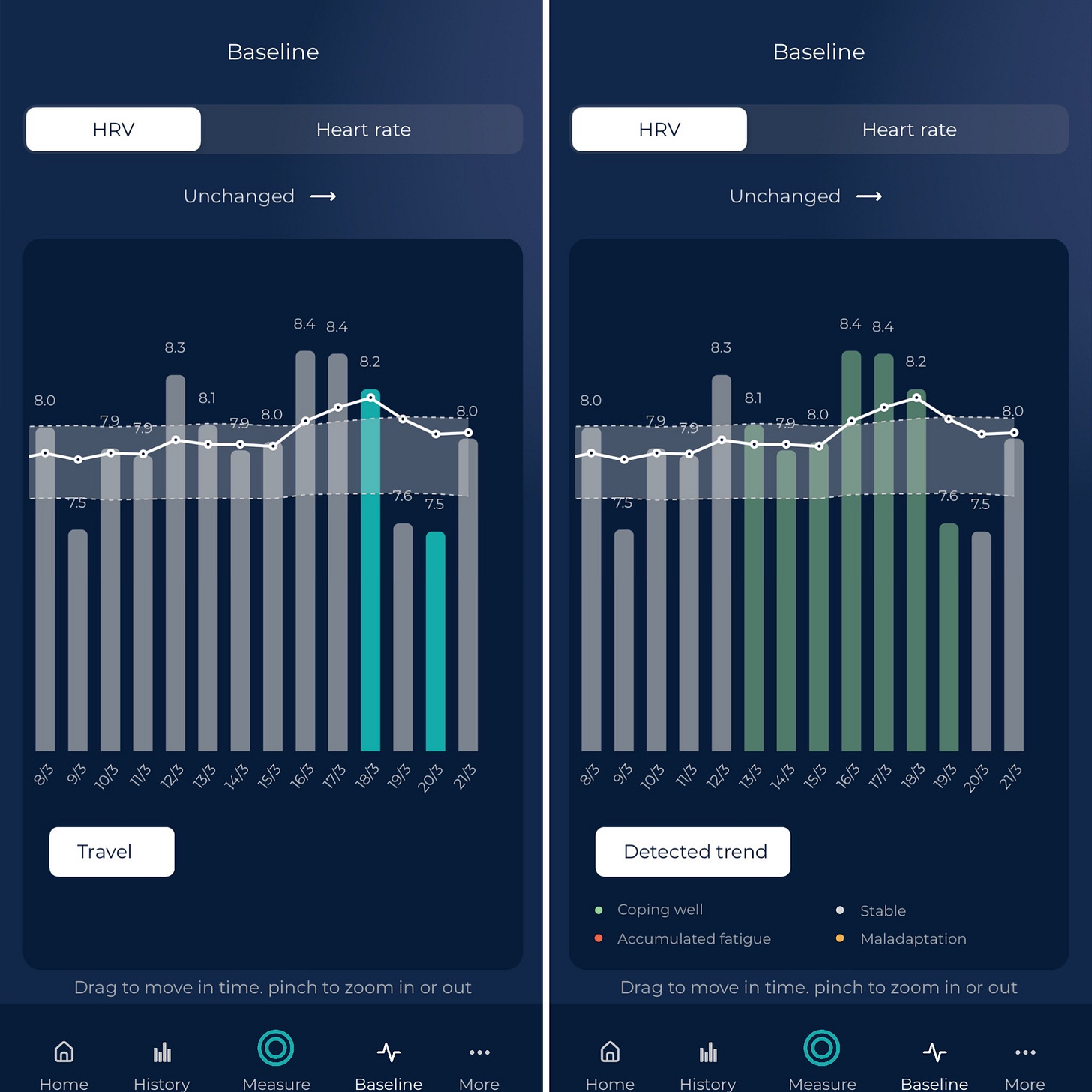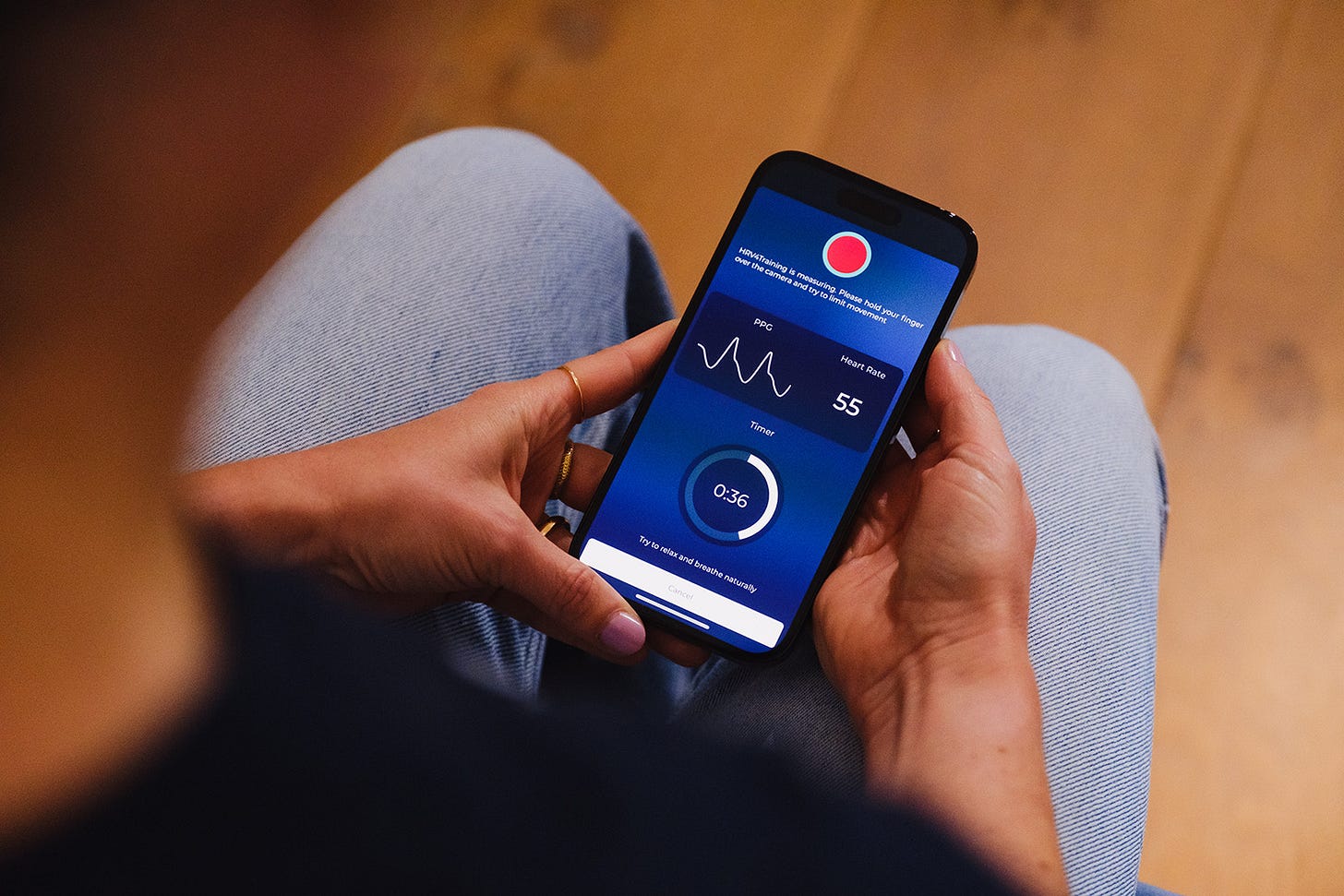Hi there 👋
Once in a while, I get a request from someone concerned with a low HRV. They want my help to increase it. It is only normal to get worried considering the amount of misinformation out there, and our poor understanding of what different values might mean.
However, with this blog, I’d like to save you time and money: I most likely cannot increase your HRV, and that’s fine.
The first thing we need to realize is that there is great uncertainty on the topic, which - if anything - highlights how being on the lower side of the spectrum doesn’t determine our destiny.
But let’s dig a bit deeper.
What’s a low HRV?
At the population level, the strongest parameter associated with HRV is age. And yet, at any age, the range of HRV values is extremely large. For example, a recent study looking at almost 100 000 people, showed how rMSSD (the typical HRV feature reported by most apps and wearables) spans between 10 and 230 ms for teenagers, and still covers a range between 5 ms and 80 ms for people in their sixties. The median value for people in their 30s is about 45 ms, with a very large standard deviation (30 ms), meaning that a large percentage of people will have relatively low values at any age. Most people having concerns typically report an rMSSD of about 20 ms or a bit lower, which is quite normal if we are in our fifties, and still rather frequent even if we are younger, according to published literature in the general population.
Alright, hopefully, we have established that you are not alone and a relatively low HRV might in fact be quite normal.
Why is my HRV low?
In most cases, we simply do not know. Like most things, our HRV is partially genetically determined and partially due to our lifestyle, the environment we live in, and all sorts of other factors.
The fact that we don’t know why HRV might be lower in certain people simply highlights how there is no clear causal association between HRV and other characteristics or outcomes (in either direction).
What does a low HRV mean?
A low HRV can be normal. Research studies looking at the relationship between HRV and health outcomes show associations, not causation, between e.g. a low HRV and negative health outcomes. Even then, it might be that HRV simply reflects a condition of poor health or poor lifestyle.
Most importantly, as highlighted in the first part of this article, there is so much overlap between any two groups of people, that it is never possible to determine if a person will have a certain outcome given their HRV. When studies find that a lower HRV is related to negative outcomes, they simply find a statistical association that means very little for the individual.
For example, in the figure below, we look at a biased sample made mostly of healthy, recreational athletes. And yet, if I were to tell you that my rMSSD is 25 ms, it would be impossible to determine my age and physical activity level: there is a lot of overlap between all groups (this is data I published here).
A low HRV is associated with older age and lower physical activity levels, but it is also quite meaningless at the individual level. A lot of people that are young and active will have a low HRV, and similarly, many people will have either a low or high HRV regardless of specific health outcomes.
Most scientific articles looking at differences in HRV between groups show similarly overlapping values. For example, recently I was reading "Different heart rate variability profile during sleep in mid-later life adults with remitted early-onset versus late-onset depression", in which, once again, significant differences were found in some HRV indices between people with a specific condition (depression in this case) and healthy controls. If we do look at the data though, we will see that there is an almost perfect overlap between categories:
rMSSD for early onset of depression: mean: 35 ms, standard deviation: 17 ms. rMSSD is not normally distributed, but this data shows a pretty broad range, probably in the order of ~10ms to ~80ms.
rMSSD for healthy controls: mean: 40 ms, standard deviation: 18 ms. As you can imagine, this is pretty much the exact same range, as the mean is slightly higher, but the standard deviation is as well. This means there are many healthy controls with an rMSSD that must be around ~10ms.
The headline is always about "the lower HRV" of a certain group, and how "higher HRV is better" but the reality of the data is that HRV is pretty much the exact same between groups: given an HRV value, you can never tell to which group a person belongs, healthy or not.
Hence, my conclusion was that we should use HRV in relative terms, and mostly ignore the absolute values, which are not very informative.
Can we change our HRV?
If we consider the entirety of the population, and in particular the recent trends in the western world (lack of physical activity, suboptimal diets, etc.) clearly we can change HRV with better lifestyle choices.
As we make lifestyle choices that prioritize our health, HRV might reflect these changes. However, if we already take care of staying active, eating well, getting enough sleep, and most importantly, keeping in check all the other various stressors we face (work, family, health, etc.), it could simply be that genetics drives much of our absolute value. This last point about considering the various stressors we face should be given uttermost importance: if you are a busy CEO with poor work-life balance, eating a salad won’t fix the problem. Training for an Ironman might just make it worse. But if you do take care of the elephant in the room, and HRV is still low, that’s probably fine.
In general, I think that we should not look at HRV as an outcome, or as something to increase. Remember that improving HRV likely means maintaining it more stable, and not necessarily increasing it, as I discuss here.
Let’s see how we can use HRV more effectively then.
How can we use HRV, regardless of its absolute value?
At the individual level, the best use of HRV is in relative terms. Looking at relative changes over time, we can identify periods of higher or lower stress, so that we can better balance stressors, regardless of our absolute HRV.
This is in my opinion the most meaningful use of this technology. For example, if our HRV today is lower than yesterday, it can mean that there is more stress on the body, and therefore it might be a good idea to try to limit additional stressors. This way, we might be able to avoid negative chronic responses (burnout, overtraining, etc.).
Below is a simple example showing how HRV can track very well different stressors, when properly analyzed (which means: looking at relative changes over time, regardless of absolutes, and with respect to our own normal range, as we do in HRV4Training).

Limiting stress on a day in which HRV is suppressed is the basic principle behind HRV-guided training, but we can likely extend this to non-training-related applications.
Note that this approach is not about avoiding stress, but better-managing stressors. A positive response to high stress always leads to a stable HRV, while suppressions are associated with poor responses (a mismatch between the stressor and our capacity to assimilate it at a given time).
Similarly, if we are not able to reduce stress, we can try to prioritize recovery, from different points of view (sleep, diet, forms of mindfulness).
Wrap up
In my opinion, it is more helpful to focus on a healthy lifestyle and to make small adjustments using HRV, than to look at absolute HRV numbers or try to increase HRV.
What matters should be health and performance, and HRV might be a parameter that provides useful feedback to make meaningful adjustments, but its absolute value does not determine the outcome in a way that is meaningful for the individual, as shown by the almost complete overlap in HRV values between groups with different clinical conditions.
I hope this was informative, and thank you for reading!
Periodized Nutrition, the N=1 Experiment with Marco Altini
A few weeks ago, I had another great chat about experimentation, individual limiters, periodized nutrition, and endurance performance (based on what I had covered in detail here), this time with Scott Tindal. Check it out at the link below.
Thank you for listening!
Endurance Coaching for Runners
If you are interested in working with me, please learn more here, and fill in the athlete intake form, here.
Discount for HRV4Training Pro: 20% off 🖥️
HRV4Training Pro is the ultimate platform to help you analyze and interpret your physiological data, for individuals and teams.
You can find a guide and overview here.
Try HRV4Training Pro for free at HRVTraining.web.app or use promo code SCIENCE for 20% off.
While we really appreciate the pledges on Substack, our writing here will always remain free, and Pro is the best way to support our work.
I thank you for that.
When using Pro, the app will also automatically recognize your account and add the Normal Range to the Baseline view, together with detected trends and additional annotations, which can help contextualizing longer-term changes.
You will also be able to pick rMSSD as the parameter to see on the homepage of the app.

See you next week!
Marco holds a PhD cum laude in applied machine learning, a M.Sc. cum laude in computer science engineering, and a M.Sc. cum laude in human movement sciences and high-performance coaching. He is a certified Ultrarunning Coach.
Marco has published more than 50 papers and patents at the intersection between physiology, health, technology, and human performance.
He is co-founder of HRV4Training, Endurance Coach at Destination Unknown, advisor at Oura, guest lecturer at VU Amsterdam, and editor for IEEE Pervasive Computing Magazine. He loves running.
Social:








I track HRV religiously with my Apple Watch and the Athlytic app. I am 71. My HRV varies from 25 to 52 and is an accurate indicator of my ‘readiness’ for training. These discussions are quite useful and well written.